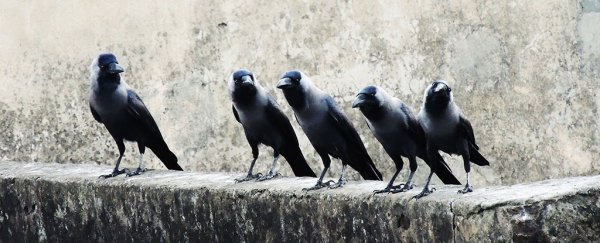Crows and ravens do not get along. The two corvid species, while very similar to each other, are often at loggerheads.
But according to new research, it's not the larger ravens that are the aggressors. As it turns out, crows - the smaller of the two - are instigating 97 percent of the altercations between them in North America.
In fact, it doesn't matter where in the continent they are - previous research suggests crows form local cultures with their own customs - it's still mostly crows ganging up in small groups to tell ravens to rack off.
Crows aren't just being jerks, though. According to over 2,000 citizen science observations collected across North America and analysed by University of British Columbia and Cornell University researchers, most of the incidents happen during the crows' breeding season from March to May.
So it's likely the crows are simply trying to protect their precious nests from ravens looking for a nutritious and easy meal, the researchers found.
When incidents occurred outside the breeding season, it was mainly in winter, which could occur for several reasons. The crows could be pre-empting the springtime nest marauding, and attempting to deter ravens from entering their territory; or, because the two birds are so similar, the crows could be attempting to drive off competition for resources.
"There are two take-home messages," said biologist Ben Freeman of the University of British Columbia's zoology department, formerly of Cornell.
"First, we show that bigger birds do not always dominate smaller birds in aggressive interactions, and that social behaviour may allow smaller birds to chase off larger birds. Second, this is a case example of the power of citizen science.
"It would be next to impossible for even the most dedicated researcher to gather this data across North America."
The researchers note that this result could have interesting implications in studying the habitats of both birds. In regions where both can be found, crows tend to live around towns and farms, while ravens prefer more wild locations.
"This tendency for crows and ravens to segregate in space could simply reflect divergent habitat preferences or availability of resources, but it could also partially be due to interactions between ravens and crows," they wrote in their paper.
"Future studies should investigate whether frequent crow attacks affect the spatial use or abundance of ravens; that is, whether crows may actually constrain raven populations."
Given that both crows and ravens can hold long grudges, that would perhaps not be such a surprising finding.
The research has been published in the journal The Auk: Ornithological Advances.
